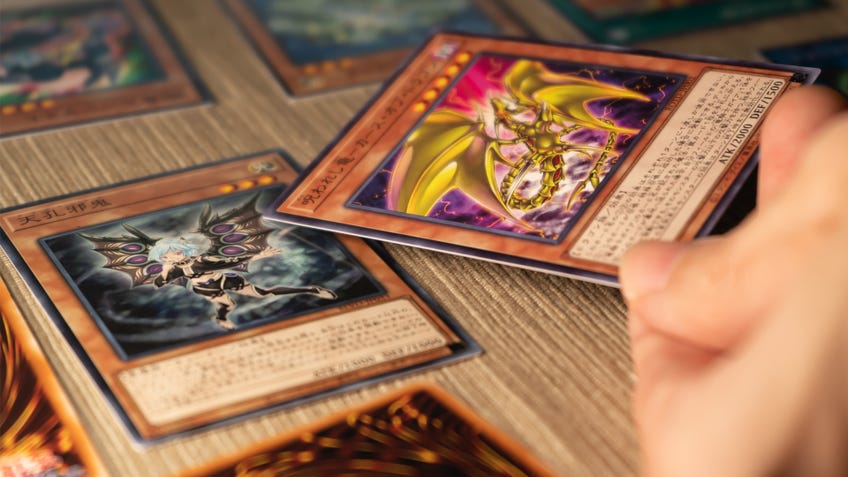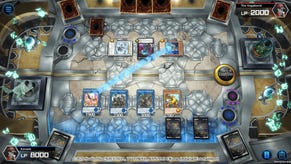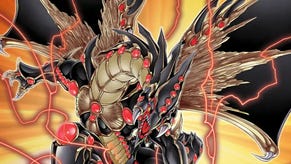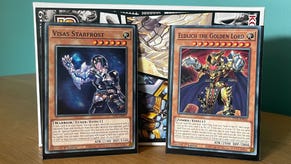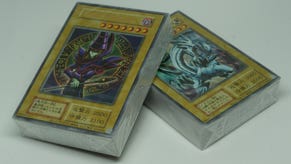How to build a Yu-Gi-Oh! deck for beginners
Take your first steps toward becoming a master duelist by putting together a top-notch deck.
Learning how to build a Yu-Gi-Oh! deck is one of the best parts of the trading card game. With the knowledge of how to play under your belt, you can now use your skills to craft the deck that will take you to victory whether you’re playing in person or online with games like Master Duel.
How to build a Yu-Gi-Oh! deck
- How many cards can you have in a Yu-Gi-Oh! deck?
- What is an Extra Deck?
- What is a Side Deck?
- How many monster, spell and trap cards should there be?
- What should be in a Yu-Gi-Oh! deck?
While the rules for making a Yu-Gi-Oh! deck are simple itself, there are a number of specifics around building a deck that you’ll want to make sure you know before cracking open the latest booster set. The last thing you want is to earn a hollow victory - or even worse, end up disqualified - by accidentally including the wrong number or type of cards in your deck, or breaking another rule. The satisfaction of knowing your Yu-Gi-Oh! deck is completely above board and primed for success in the duelling arena means you can focus on summoning your prize monsters, laying down traps for your unsuspecting opponent and executing your next showstopping combo.
To get you started on your path to duelling greatness, we’ve put together the following guide on everything you need to know when building a Yu-Gi-Oh! deck. Whether you’re a beginner looking to make your first deck or a veteran needing to remind yourself of the specifics, you’ll find it below. All you’ll need after this are some cards and an idea for your next great deck - and the heart of the cards, of course.
How many cards can you have in a Yu-Gi-Oh! deck?
The official rules for building a Yu-Gi-Oh! deck specify that your Main Deck must contain between 40 and 60 cards.
While you must have at least 40 cards and can have up to a maximum of 60 cards in your deck, our recommendation would be to try and keep that number as close to 40 as possible. This will help you increase the chances of drawing your best cards during a duel - and even starting with them in your hand on the first turn - which can often be crucial to victory.
On top of the 40 to 60 cards allowed in your Main Deck, you may have up to 15 cards in your Extra Deck and a maximum of 15 cards in your Side Deck. You don’t have to have any cards in your Extra Deck or Side Deck, but any cards you do include are not counted towards the 40 to 60-card limit for your Main Deck.
You can typically include up to three copies of any one card with the same name in total across your Main Deck, Extra Deck and Side Deck. This is when a card is referred to as ‘Unlimited’. However, some cards are restricted to just two or one copies in total - and some are banned completely from use in official tournaments. Make sure you check the latest Yu-Gi-Oh! banlist if you plan on participating in a tournament to ensure your deck is legal to use.

What is an Extra Deck in Yu-Gi-Oh?
An Extra Deck in Yu-Gi-Oh! is where your Xyz monsters, Synchro monsters, Link monsters and Fusion monsters are kept during a duel. Your Extra Deck is separate to your Main Deck, and is placed facedown in a different space - the Extra Deck Zone - on the battlefield during setup.
Unlike your Main Deck, you do not have to shuffle your Extra Deck during setup and can look through your cards at any time. The player can summon monsters directly from their Extra Deck by following the necessary rules for Xyz, Synchro, Link, Fusion, Pendulum and other Special summons.
When Xyz, Synchro, Link and Fusion monsters would be sent to the graveyard or a player’s hand, they are instead returned to the Extra Deck. While Pendulum monsters are not necessarily included in the Extra Deck (unless they are also an Xyz, Synchro, Link or Fusion monster), the Extra Deck is also where Pendulum monsters are sent instead of the graveyard.
You may have a maximum of 15 cards in your Extra Deck, but you can choose to have zero cards. Any cards you include are not counted towards the deck limit of your Main Deck, but still count towards the limit of how many copies of a single card can be included across your Main, Extra and Side decks in total depending on whether it is Unlimited, Semi-Limited, Limited or Forbidden.
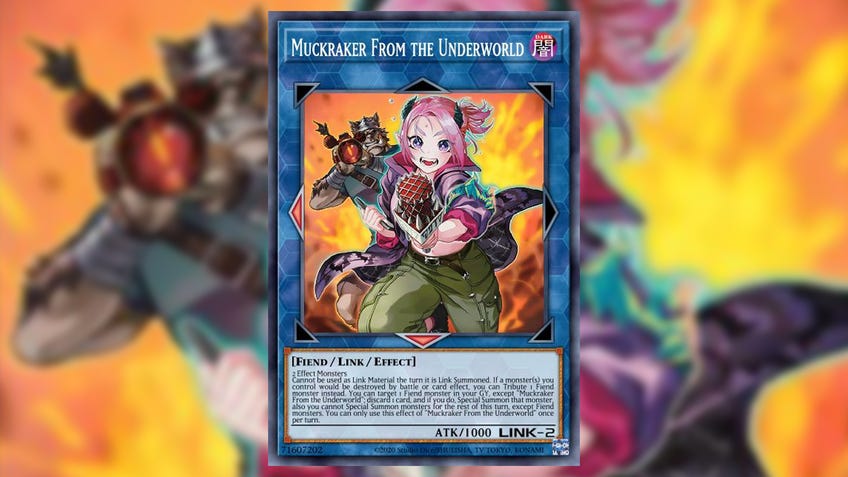
What is a Side Deck in Yu-Gi-Oh!?
A Side Deck in Yu-Gi-Oh! is an additional deck of cards that players can access between duels, allowing them to swap cards in and out of their Main Deck and Extra Deck. While using a Side Deck isn’t required, it is common in official tournaments.
Unlike their Main Deck and Extra Deck, players cannot access the contents of their Side Deck during a duel. However, they must let their opponent know how many cards their Side Deck includes, without revealing which cards, if they are using one.
After their first duel, and between each duel from then on, each player can choose to replace cards in their Main Deck and/or Extra Deck with cards from their Side Deck. The players can swap any number of cards between the decks, with the requirement that each deck must have exactly the same number of cards as it had before. For example, if you add two cards from your Side Deck to your Main Deck, you must also remove two cards from your Main Deck to your Side Deck.
A Side Deck may include up to 15 cards, but can include zero. Cards included in the Side Deck do not count towards the card limit of the player’s Main Deck. However, cards included in the Side Deck still count towards the total number of copies of any one card that can be included across the Main, Extra and Side decks combined according to its Unlimited, Semi-Limited, Limited or Forbidden status.

How many monster, spell and trap cards should there be in a Yu-Gi-Oh! deck?
While you can include any combination of monster, spell and trap cards in your Yu-Gi-Oh! deck, as long as you abide by the overall rules for each deck’s maximum number of cards and any Unlimited, Limited or Forbidden restrictions, a decent rule of thumb for beginners building a Yu-Gi-Oh! deck is to have around half of your Main Deck be monsters, with the remainder split evenly between spells and traps.
That means in a typical 40-card deck, you’ll want roughly 20 monsters, 10 spells and 10 traps. Bear in mind that those aren’t exact numbers, as the number of monster, spell and trap cards in your deck will ultimately come down to what you’re trying to achieve during a duel - you may have more or less of each type of card. Some players may seek victory by laying endless traps for their opponent or pelting them up with spells, while others will choose to go all-in on powerful monsters to overwhelm them with summons.
Regardless, you’ll want to make sure that you’re including enough low-level monsters so you can use them as tributes and materials for higher-level monsters - otherwise you risk ending up with a hand of cards you can’t even play. Aim for most of your monsters to be levels one to four, with just a couple to a handful being level five and up. That’s why it’s generally a good idea to aim for 40 cards in your deck, too, boosting the chances you’ll draw the cards you need early on to get your deck’s engine up and running.

What should be in a Yu-Gi-Oh! deck?
What to include in a Yu-Gi-Oh! deck comes down to what you want to do with it! As a starting place, you might decide to build around one of the card game’s popular archetypes - themes that encapsulate cards’ keywords, gameplay effects and lore, such as Elemental Hero, Fire Warrior or Vampire.
Archetypes can be a useful way to discover interesting combinations of cards that work well together, using their linked abilities to drive your deck’s power to summon, attack and disrupt your opponent. Many of the very best Yu-Gi-Oh! decks used by high-level players in tournaments are built around specific archetypes that make full potential of their unique strengths.
While just throwing a load of random cards together isn’t likely to yield great results, part of the fun of Yu-Gi-Oh! - any trading card game, in fact - is experimentation. If there’s a particular card you like, whether that’s because of its gameplay effect or simply because you like the artwork, try looking at other cards with similar keywords or that are referenced in the text on the card. Give your deck a go against some friends or in casual duels, or even just shuffle it up and draw a practice starting hand, to see what works - and what doesn’t - and then adjust as necessary.
If you’re still learning how to play Yu-Gi-Oh!, you could start by using one of the premade starter or structure decks available, seeing how their cards work together, and then tweaking it to create your own variant by adding and removing cards rather than building a complete Yu-Gi-Oh! deck from scratch.
